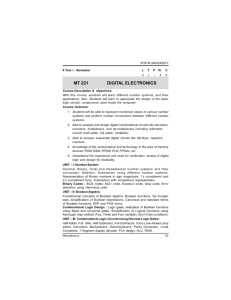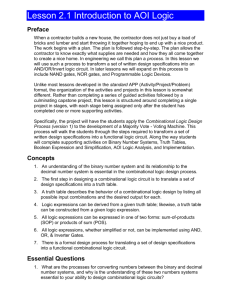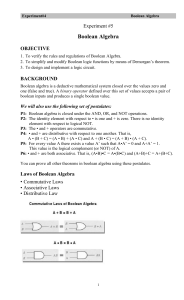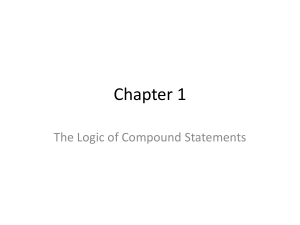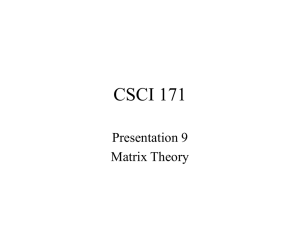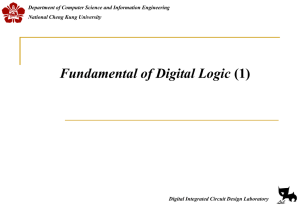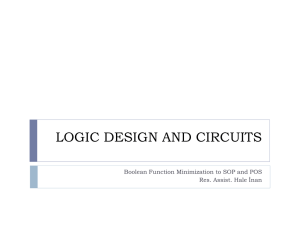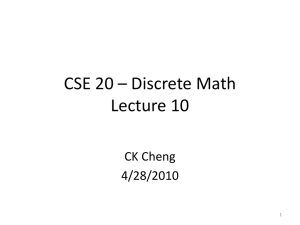Digital Logic: Computer Architecture Presentation
advertisement
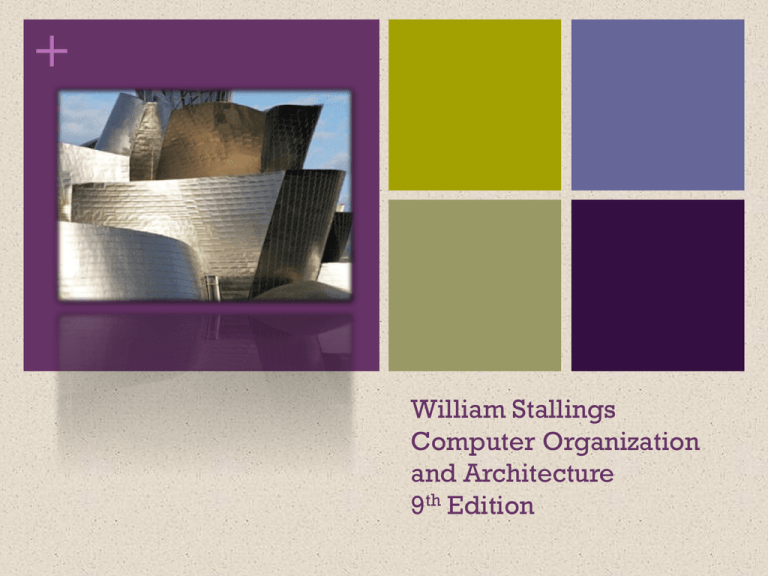
+ William Stallings Computer Organization and Architecture 9th Edition + Chapter 11 Digital Logic + Boolean Algebra Mathematical discipline used to design and analyze the behavior of the digital circuitry in digital computers and other digital systems Named after George Boole English mathematician Proposed basic principles of the algebra in 1854 Claude Shannon suggested Boolean algebra could be used to solve problems in relay-switching circuit design Is a convenient tool: Analysis It is an economical way of describing the function of digital circuitry Design Given a desired function, Boolean algebra can be applied to develop a simplified implementation of that function + Boolean Variables and Operations Makes use of variables and operations AND Yields true (binary value 1) if and only if both of its operands are true In the absence of parentheses the AND operation takes precedence over the OR operation When no ambiguity will occur the AND operation is represented by simple concatenation instead of the dot operator OR Are logical A variable may take on the value 1 (TRUE) or 0 (FALSE) Basic logical operations are AND, OR, and NOT Yields true if either or both of its operands are true NOT Inverts the value of its operand Table 11.1 Boolean Operators (a) Boolean Operators of Two Input Variables (b) Boolean Operators Extended to More than Two Inputs (A, B, . . .) Table 11.2 Basic Identities of Boolean Algebra Table 11.2 Basic Identities of Boolean Algebra + Basic Logic Gates + Uses of NAND Gates + Uses of NOR Gates Combinational Circuit An interconnected set of gates whose output at any time is a function only of the input at that time The appearance of the input is followed almost immediately by the appearance of the output, with only gate delays Consists of n binary inputs and m binary outputs Can be defined in three ways: • Truth table • For each of the 2n possible combinations of input signals, the binary value of each of the m output signals is listed • Graphical symbols • The interconnected layout of gates is depicted • Boolean equations • Each output signal is expressed as a Boolean function of its input signals + Boolean Function of Three Variables Table 11.3 A Boolean Function of Three Variables + Sum-of-Products Implementation of Table 11.3 + Product-of-Sums Implementation of Table 11.3 + Algebraic Simplification Involves the application of the identities of Table 11.2 to reduce the Boolean expression to one with fewer elements + Karnaugh Map A convenient way of representing a Boolean function of a small number (up to four) of variables Example Karnaugh Maps + Overlapping Groups + + Table 11.4 Truth Table for the One-Digit Packed Decimal Incrementer Table 11.4 Truth Table for the One-Digit Packed Decimal Incrementer Figure 11.10 + Table 11.5 First Stage of Quine-McCluskey Method Table 11.5 First Stage of Quine-McCluskey Method Table 11.6 Last Stage of Quine-McCluskey Method Table 11.6 Last Stage of Quine-McCluskey Method + NAND and NOR Implementations + Multiplexers - connect multiple inputs to a single output + 4-to-1 Multiplexer Truth Table Table 11.7 4-to-1 Multiplexer Truth Table + Multiplexer Input to Program Counter + Decoders - combinational circuits with a number of output lines, only one of which is asserted at any time Address Decoding Implementation of a Demultiplexer Using a Decoder + Read-Only Memory (ROM) Memory that is implemented with combinational circuits Combinational circuits are often referred to as “memoryless” circuits because their output depends only on their current input and no history of prior inputs is retained Memory unit that performs only the read operation Binary information stored in a ROM is permanent and is created during the fabrication process A given input to the ROM (address lines) always produces the same output (data lines) Because the outputs are a function only of the present inputs, ROM is a combinational circuit Table 11.8 + Truth Table for a ROM Binary Addition Truth Tables Table 11.9 Binary Addition Truth Tables 4-Bit Adder + Implementation of an Adder Construction of a 32-Bit Adder Using 8-Bit Adders Sequential Circuit Current output depends not only on the current input, but also on the past history of inputs Sequential Circuit Makes use of combinational circuits + Flip-Flops Simplest form of sequential circuit There are a variety of flip-flops, all of which share two properties: 1. The flip-flop is a bistable device. It exists in one of two states and, in the absence of input, remains in that state. Thus, the flip-flop can function as a 1-bit memory. 2. The flip-flop has two outputs, which are always the complements of each other. + The S-R Latch + NOR S-R Latch Timing Diagram Table 11.10 The S-R Latch Clocked S-R Flip-Flop D Flip-Flop J-K Flip Flop + Basic Flip-Flops Parallel Register 5-Bit Shift Register + Counter A register whose value is easily incremented by 1 modulo the capacity of the register After the maximum value is achieved the next increment sets the counter value to 0 An example of a counter in the CPU is the program counter Can be designated as: Asynchronous Relatively slow because the output of one flip-flop triggers a change in the status of the next flip-flop Synchronous All of the flip-flops change state at the same time Because it is faster it is the kind used in CPUs Ripple Counter + Design of a Synchronous Counter Table 11.11 Programmable Logic Devices (PLD) Terminology + Programmable Logic Array (PLA) + Structure of a Field-Programmable Gate Array (FPGA) Simple FPGA Logic Block Summary + Digital Logic Chapter 11 Sequential Circuits Boolean Algebra Gates Flip-Flops Combinational Circuits Registers Counters Implementation of Boolean Functions Multiplexers Decoders Read-Only-Memory Adders Programmable Logic Devices Programmable Logic Array Field-Programmable Gate Array
